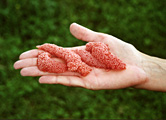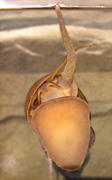Ampullariidae: Difference between revisions
m Fix link to Genera. |
GrahamBould (talk | contribs) mNo edit summary |
||
| Line 87: | Line 87: | ||
* [http://www.hear.org/articles/levin2006/ Statewide strategic control plan for apple snail (''Pomacea canaliculata'') in Hawaii (Levin 2006)] |
* [http://www.hear.org/articles/levin2006/ Statewide strategic control plan for apple snail (''Pomacea canaliculata'') in Hawaii (Levin 2006)] |
||
[[Category: |
[[Category:Ampullariidae]] |
||
[[de:Apfelschnecken]] |
[[de:Apfelschnecken]] |
||
Revision as of 07:36, 4 December 2007
| Apple snails | |
|---|---|
| File:Pomacea bridgesii purple-yellow.jpg | |
| Spike-topped apple snail Pomacea bridgesii | |
| Scientific classification | |
| Kingdom: | |
| Phylum: | |
| Class: | |
| Subclass: | |
| Infraclass: | |
| Superorder: | |
| Order: | |
| Superfamily: | |
| Family: | Ampullariidae
|
| Genera | |
|
Afropomus | |
| Synonyms | |
|
Pilidae | |
The family Ampullariidae - commonly referred to as apple snails - are large tropical and subtropical amphibious freshwater snails, gastropod mollusks.
The Ampullariidae are peculiar because they have both gills and lungs, the mantle cavity being divided to separate the two types of respiratory structures.
Range of Distribution
This family includes several genera. Asolene, Felipponea, Marisa, and Pomacea are New World genera (native to South America, Central America, the West Indies and the Southern U.S.A.). The genera Afropomus, Lanistes, and Saulea are found in Africa. The genus Pila is native to both Africa and Asia.
Adaptations

Apple snails are exceptionally well adapted to tropical regions characterized by periods of drought alternating with periods of high rainfall. This adaptation is reflected in their life style: moderately amphibious and being equipped with a shell "door" or operculum enabling the snail to close itself off in the shell to prevent drying out while hiding in the mud during dry periods.
One of the more typical adaptations of apple snails is the branchial respiration. The snail has a system comparable to the gills of a fish (at the right side of the snail body) to breathe under water as well as a lung (at the left side of the body) to respirate air. This lung/gill combination expands the action radius of the snail in search for food. It is part of the snail's natural behaviour to leave the water when the food supply below the surface becomes inadequate.
Several apple snail genera (Pomacea, Pila and Asolene/Pomella) deposit eggs above the waterline in calcareous clutches. This remarkable strategy of aquatic snails protects the eggs against predation by fish and other aquatic inhabitants. Another anti-predator adaptation in the apple snail genera Pomacea and Pila, is the tubular siphon, used to breathe air while submerged, reducing vulnerability to attacking birds.
Apple snails inhabit various ecosystems: ponds, swamps and rivers. Although they occasionally leave the water, they mainly spend time in the water. Unlike many snail species, apple snails are not hermaphroditic, but gonochoristic: a male and a female are needed for reproduction.
Importance to humans
Common aquarium pet

Apple snails are popular aquarium-pets because of their attractive appearance and size. When properly cared for, some apple snail species can reach 15 cm / 6 inch diameter. Apple snails are in fact the biggest living freshwater snails on earth.
The most common apple snail in aquarium shops is Pomacea bridgesii (spike-topped apple snail). This species comes in different colours from brown to albino or yellow and even blue, with or without banding. Another common apple snail is Pomacea canaliculata; this snail is bigger, rounder and is more likely to eat aquatic plants, which makes it less suitable for most aquaria. This species also come in different shell and body colours. The "giant ramshorn snail" (Marisa cornuarietis) although not always recognized as an apple snail due to its discoidal shape, is also a popular aquatic pet. Occasionally, the Florida apple snail (Pomacea paludosa) is found in the aquarium trade and these are often collected in the wild from ditches and ponds in Florida. The giant Pomacea maculata rarely finds its way into aquaria.
Apple snails are often sold under the name "golden (ivory, blue, black...) mystery snail" and they are given incorrect names like Ampullarius for the genus instead of Pomacea and wrong species names like gigas instead of maculata. These snails will "play dead" on occasion (especially when first introduced to a new tank, probably from the stress of moving from one habitat to another), even for several days, but once the snail is acclimated it will become a surprisingly active (albeit slow motion) participant in the community tank.
A pest
In the 1980s, Pomacea canaliculata was introduced in Taiwan to start an escargot industry (Halwart 1994). It was thought that such food culture could provide valuable proteins for farmers, who primarily live on a rice diet. However, the snails did not become a culinary success because the imported snails (like the native apple snail population, Pila) were able to transfer a parasite called Angiostrongylus cantonensis. This parasite can infect humans if snails are eaten which have not been cooked thoroughly.
Instead of becoming a valuable food source, the introduced snails escaped and became a serious threat to rice production and the native ecosystems. During the 1980s the introduced snails rapidly spread to Indonesia, Thailand, Cambodia (Jahn et al. 1998), Hong Kong, southern China, Japan and the Philippines, and there are indications that they are currently invading Australia.
Hawai'i experienced the same introduction of Pomacea for culinary purposes, and its taro industry is now suffering because of it.
Nevertheless, apple snails are considered a delicacy in several regions of the world, and they are often sold in East and Pacific Asian markets for consumption.
Bio-control
Pomacea and Marisa species have been introduced to Africa and Asia to control snails (Planorbidae: Bulinus sp. and Biophalaria sp.) that serve as an intermediate host for trematoda parasites. These parasites can cause swimmers itch and schistosomiasis, a disease that affects over 200 million people in tropical regions. One of the species introduced as bio-agent is Marisa cornuarietis. This snail competes with other snails and predates on other species. Hopefully Marisa will not develop into a pest as have the introduced Pomacea species in Asia.
References
- Halwart, M. 1994. The golden apple snail Pomacea canaliculata in Asian rice farming systems: present impact and future threat. International journal of pest management (Int. j. pest manag.) ISSN 0967-0874. vol. 40, no2, pp. 199-206 (1 p.1/4)
- Jahn, G. C., S. Pheng, B. Khiev, and C. Pol 1998. Pest potential of the golden apple snail in Cambodia. Cambodian Journal of Agriculture 1:34-35.
- Baldia, J. P. & Pantastico, J. B. 1991. Environmental impact of the golden snail (Pomacea sp.) on rice farming systems in the Philippines. Wallaceana, no.65(1991): 14-16.
- Berthold, T. 1991. Vergleichende Anatomie, Phylogenie und historische Biogeographie der Ampullariidae. Abhandlungen des naturwissenschaftlichen Vereins in Hamburg (NF) 29, 256 pp.
- Bieler, R. 1993. Book Review (Vergleichende anatomie ... Berthold, T, 1991) and Cladistic Re-analysis. The Veliger, 36(3): 291-297.
- Cazzaniga, N. J. 2002. Old species and new concepts in the taxonomy of Pomacea (Gastropoda: Ampullariidae). Biocell, 26(1): 71-81.
- Cowie, R.H. 2001. Can snails ever be effective and safe biocontrol agents? International Journal of Pest Management 47(1): 23-40.
- McClary, A. 1962.Surface inspiration and ciliary feeding in Pomacea paludosa (Prosobranchia: Mesogastropoda: Ampullariidae). Malacologia, 2(1): 87-104.
- Meenakshi, V. R. 1956. Physiology of hibernation of the apple-snail Pila virens (Lamarck). Current Science, 10: 321-323.
